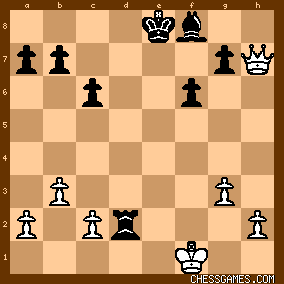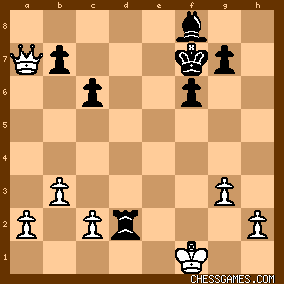| Jul-22-10 | | Creative: Beautiful game, but i don't understand 21. Bxh7 Rd6??. |
|
| Jul-22-10 | | MrMelad: After 21.Bxh7 what can black do?
if 21..Rf8 then 22.Bg6+ and white wins the rook.
if 21..Rxh7 then 22.Qg8+ and white wins the rook.
Any other move fail to 22.Bg6+
Hope it helps.. |
|
| Jul-22-10 | | Creative: My pc say:
21... Rxh7 22. Qg8 Bf7 23. Qxh7 Rxd2 24. c4 Rxh1 25. h4 Ke7 26 Qe4 Bc5 27 Qg4 f5 28. Qxg2 Kc8 29. Qe4 0-0 (Grand Master Chess). |
|
| Jul-22-10 | | MrMelad: I don't know about 24. c4 in your variation.

click for larger view I would go for some checks and snatching some pawns with 24.Qh5+ Ke7 (24..Kd7 25.Qf7+ and the g pawn is ripe and tasty for the white queen, and 24..Kd8?? looses the rook after 25.Qa5++) 25.Qc5+ Kf7 26.Qxa7 and now white is one tempo ahead to exterminate black's left side pawns. 
click for larger view26..Rxc2 27.Qxb7 etc..
24.c4? in your variation leads to a tough endgame after 24..Rxa2 when suddenly the white queen must guard h2 and black rook is free to wonder around, but of course, Q is usually much better then R+B so white should win in any case. |
|
| Feb-20-11 | | YourNickname: 21... Rxh7 loses the rook, but not the game. The Rook and the Bishop can simply defend the other pawns. Look at this variation. 21 ... - Rxh7
22 Qg8+ - Kd7
23 Qxh7 - Ked
24 Ke2 - Bf8
25 Qg8+ - Ke7
26 Qc4 - Ke8
27 Qe6+ - Be7
28 h4 - Kf8
29 h5 - Re8 etc, |
|
Feb-20-11
 | | Sastre: After 21...Rxh7 22.Qg8+ Kd7 23.Qxh7+ Ke6, White has <24.Qxg7 Rxd2 25.h4 Rxc2 26.h5 f5 27.h6 Rc1+ 28.Kg2 Rc2+ 29.Kh3 b5 30.h7 Bf6 31.Qxf6+ Kxf6 32.h8Q+  >. >. |
|
Dec-04-21
 | | GrahamClayton: 9. Nc3 or 9. c3 loses the queen after 9...Bf3, while 9. d3/d4 loses both bishop and rook, so Hahn is forced to sacrifice the rook by 9. Bg4. The sacrifice works out well - Vitense's queen is out of play while Hahn quickly develops his pieces. |
|
| May-26-22 | | TheaN: <GrahamClayton: Hahn is forced to sacrifice the rook by 9. Bg4. The sacrifice works out well> This is what we'd otherwise call 'position's luck'. White's not really playing a good game up to this point; opening's at least not gained him anything (7....h5 evaluates +0.01) but Black plays into the undeveloped camp incorrectly, as 7....Qh4+?! (+1.5) sets himself up. After 8.g3 Qf6 9.Bxg4 Qxa1 10.Nc3 ± Black's the one with zero development and a trapped queen. |
|
| May-26-22 | | TheaN: It's kind of weird how the best response to such a flank structure is how he started, but then simply trading: 4....Nxf3!? 5.Qxf3 d5 ⩱ gives Black the advantage because White has a developed queen that does, well, nothing, and the center's Black's. |
|
May-26-22
 | | OhioChessFan: Amazingly enough, Nimzo opened 1. e3 nine times. https://www.chessgames.com/perl/che... Amusing, quirky pun by <Dom>. |
|
May-26-22
 | | FSR: https://www.youtube.com/watch?v=ySv... |
|
May-26-22
 | | FSR: Another posthumous pun from the late great <Domdaniel>, following W Zili vs Hug, 1989. |
|
May-26-22
 | | FSR: Black "won" two rooks for a queen, but was in difficulties after 16.e4 ("Best by test" - R. Fischer?). Stockfish 15 recommends giving up a pawn to get castled with 16...O-O 17.exd5 Rad8, though Black's pieces remain uncoordinated and White has a serious advantage (+0.92). |
|
| May-26-22 | | goodevans: <TheaN: [...] This is what we'd otherwise call 'position's luck'.> I guess both players were playing by the seat of their pants. I'd be inclined to give both the benefit of the doubt and say they both saw from early on Black winning the exchange but getting his Q trapped. Black probably thought he could extract her by attacking White's N and White probably had a plan to ready himself for Ba3 to win the Q. In a position this ripe with possibilities I don't believe either player knew for certain their plan would work so <'position's luck'> indeed. In the end White's plan won out ... sort of. In fact <14.Ba3> released the tension a little too early and as <FSR> pointed out 16...O-O would have made life more difficult for White. Instead <14.Qf4!> would have maintained the pressure. 
click for larger viewNow <14...Bxc3 15.Ba3 Qxa2 16.Qd6> forces Black to give up his Q or get mated whilst after <14...c5>, for instance, <15.Ba3> is much stronger, e.g. <15...Qxf1+ 16.Kxf1 Bxa3 17.Qa4+>. A hugely enjoyable game to play through and a wonderful finish with 21.Bxh7. |
|
May-26-22
 | | OhioChessFan: After looking at Bxh7, I wonder if I've missed that tactic in my games. Once you see it played, it's obvious, but not so much beforehand. |
|
| May-27-22 | | RookFile: Domdaniel, you're still remembered here. |
|





